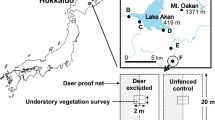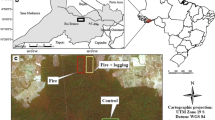Abstract
Quantitative relationships between the aboveground biomass of dwarf bamboo, Sasa nipponica, and the survivorship and emergence of seedlings of Abies homolepis, Fraxinus lanuginosa f. serrata, and Fagus crenata were estimated. We show that dwarf bamboo acts as an ecological filter since the responses of tree species differ according to the biomass of dwarf bamboo. Deer exclusion without management of dwarf bamboo would make it impossible for any tree species to regenerate due to rapid increases in the biomass of dwarf bamboo.


Similar content being viewed by others
References
Agata W, Kamata E (1979) Ecological characteristics and dry matter production of some native grasses in Japan I. Annual growth pattern of Sasa nipponica community. J Jpn Grassl Sci 25:103–109 (in Japanese with English summary)
Cross JR (1981) The establishment of Rhododendron ponticum in the Killarney Oakwoods, S. W. Ireland. J Ecol 69:807–824
Furusawa H, Miyanishi H, Kaneko S, Hino T (2003) Movement of soil and litter on the floor of a temperate mixed forest with an impoverished understory grazed by deer (Cervus nippon centralis Temminck). J Jpn For Soc 85:318–325 (in Japanese with English summary)
George LO, Bazzaz FA (1999a) The fern understory as an ecological filter: growth and survival of canopy-tree seedlings. Ecology 80:846–856
George LO, Bazzaz FA (1999b) The fern understory as an ecological filter: emergence and establishment of canopy-tree seedlings. Ecology 80:833–845
Hiura T, Sano J, Konno Y (1995) Age structure and response to fine-scale disturbances of Abies sachalinensis, Picea jezoensis, Picea glehnii, and Betula ermanii growing under the influence of a dwarf bamboo understory in northern Japan. Can J For Res 26:289–297
Itô H, Hino T (2003) Stand structure of a mixed forest in Mt. Ôdaigahara. Appl For Sci 12:163–165 (in Japanese)
Itô H, Hino T (2004) Effects of deer, mice and dwarf bamboo on the emergence, survival and growth of Abies homolepis (Piceacea) seedlings. Ecol Res 19:217–223
Itô H, Hino T (2005) How do deer affect tree seedlings on a dwarf bamboo-dominated forest floor? Ecol Res 20:121–128
Koike T (1986) Photosynthetic responses to light intensity of deciduous broad-leaved tree seedlings raised under various artificial shade. Environ Control Biol 24:51–58
Lei TT, Semones SW, Walker JF, Clinton BD, Nilsen ET (2002) Effects of Rhododendron maximum thickets on tree seed dispersal, seedling morphology, and survivorship. Int J Plant Sci 163:991–1000
Maeji I, Yokoyama S, Shibata E (1999) Population density and range use of sika Deer, Cervus nippon, on Mt. Ohdaigahara, Central Japan. J For Res 4:235–239
Maguire DA, Forman RTT (1983) Herb cover effects on tree seedling patterns in a mature hemlock-hardwood forest. Ecology 64:1367–1380
Nakashizuka T (1987) Regeneration dynamics of beech forests in Japan. Vegetatio 69:169–175
Nakashizuka T (1988) Regeneration of beech (Fagus crenata) after the simultaneous death of undergrowing dwarf bamboo (Sasa kurlensis). Ecol Res 3:21–35
Nakashizuka T (1991) Population dynamics of coniferous and broad-leaved trees in a Japanese temperate mixed forest. J Veg Sci 2:413–418
Nakashizuka T, Numata M (1982) Regeneration process of climax beech forests I. Structure of a beech forest with the undergrowth of Sasa. Jpn J Ecol 32:57–67
Narukawa Y, Yamamoto S (2002) Effects of dwarf bamboo (Sasa sp.) and forest floor microsites on conifer seedling recruitment in a subalpine forest, Japan. For Ecol Manag 163:61–70
Peters R, Nakashizuka T, Ohkubo T (1992) Regeneration and development in beech-dwarf bamboo forest in Japan. For Ecol Manag 55:35–50
R Development Core Team (2005) R: a language and environment for statistical computing. R Foundation for Statistical Computing, Vienna, Austria
Rooney TP (2001) Deer impacts on forest ecosystems: a North American perspective. Forestry 74:201–208
Smith LL, Vankat JL (1991) Communities and tree seedling distribution in Quercus rubra- and Prunus serotina-dominated forests in southwestern Pennsylvania. Am Midl Nat 126:294–307
Takatsuki S (1983) The importance of Sasa nipponica as a forage for Sika deer (Cervus nippon) in Omote-Nikko. Jpn J Ecol 33:17–25
Takatsuki S (1986) Food habits of Sika Deer on Mt. Goyo, Northern Honshu. Ecol Res 1:119–128
Takatsuki S (1990) Dwarf bamboos as food for Sike Deer in Japan. Bamboo J 8:56–63
Taylor AH, Qin Z (1988) Regeneration patterns in old-growth Abies-Betula forests in the Wolong Natural Reserve, Sichuan, China. J Ecol 76:1204–1218
Taylor AH, Huan J, Zhou S (2004) Canopy tree development and undergrowth bamboo dynamics in old-growth Abies-Betula forests in southwestern China: a 12-year study. For Ecol Manag 200:347–360
Wada N (1993) Dwarf bamboos affect the regeneration of zoochorous trees by providing habitats to acorn-feedking rodents. Oecologia 94:403–407
Waller DM, Alverson WS (1997) The white-tailed deer: a keystone herbivore. Wildl Soc Bull 25:217–226
Xiong S, Nilsson C (1999) The effects of plant litter on vegetation: a meta-analysis. J Ecol 87:984–994
Yokoyama S, Shibata E (1998a) Characteristics of Sasa nipponica grassland as a summer forage rosouce for sika deer on Mt Ohdaigahara, central Japan. Ecol Res 13:193–198
Yokoyama S, Shibata E (1998b) The effects of sika-deer browsing on the biomass and morphology of a dwarf bamboo, Sasa nipponica, in Mt. Ohdaigahara. For Ecol Manag 103:49–56
Acknowledgments
We are grateful to H. Furusawa, Y. Takahata, A. Ueda, T. Shimada, S. Chikaguchi, and S. Narayama (Forestry and Forest Products Research Institute) for their support, the staff of the Ôdaigahara Visitors’ Center of the Ministry of Environment, and S. and S. Tagaito (Ôdai Shrine) for their kind cooperation during our fieldwork. We also thank Prof. E. Shibata (Nagoya University), Prof. T. Nakashizuka (Research Institute for Humanity and Nature), Prof. K. Kikuzawa (Ishikawa Prefectural University), Dr. T. Kubo (Hokkaido University) for their helpful comments on our research. This study was supported by grants from the Ministry of Environment (Environmental Research by National Research Institutes of Government Ministries and Agencies, 1999–2002) and the Ministry of Education, Culture, Sports, Science and Technology of Japan (No. 14206019, 2002–2005).
Author information
Authors and Affiliations
Corresponding author
About this article
Cite this article
Itô, H., Hino, T. Dwarf bamboo as an ecological filter for forest regeneration. Ecol Res 22, 706–711 (2007). https://doi.org/10.1007/s11284-006-0066-0
Received:
Accepted:
Published:
Issue Date:
DOI: https://doi.org/10.1007/s11284-006-0066-0




